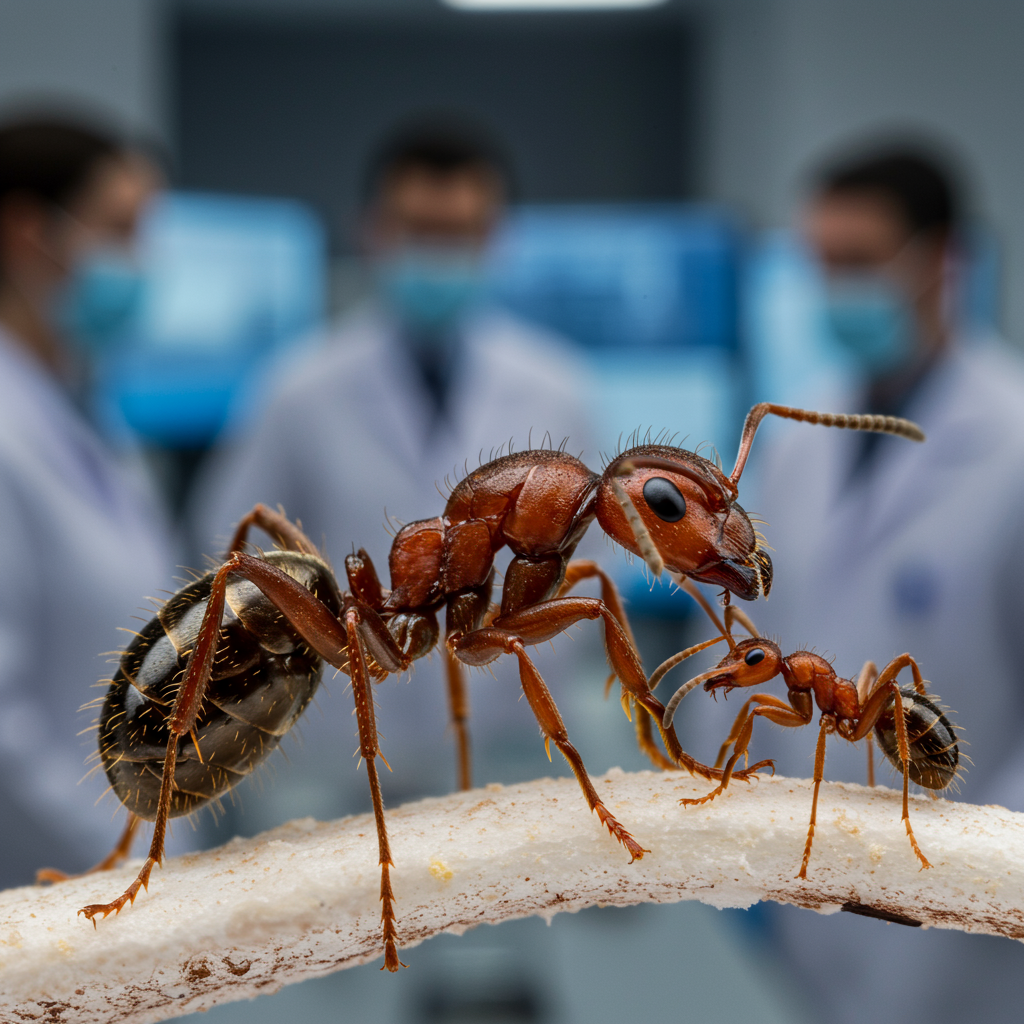Imagine a world where a mother gives birth to offspring of a completely different species. This sounds like science fiction, an anomaly so profound it challenges the very bedrock of biological understanding. Yet, recent groundbreaking research has revealed precisely such a phenomenon occurring in the insect world. Scientists have discovered that a specific type of Mediterranean harvester ant queens are producing male offspring that belong to an entirely separate ant species. This unprecedented finding compels us to re-evaluate what we thought we knew about species boundaries and the fundamental rules governing life on Earth, prompting fascinating questions about evolution, genetics, and the intricate strategies within an ant colony.
The Unthinkable Discovery: When Species Boundaries Blur
For centuries, biology has operated on a foundational principle: an animal parent begets offspring of its own kind. Humans produce humans, canines produce canines, and felines produce felines. While nature occasionally surprises us with hybrids, such as the mule (a cross between a horse and a donkey) or the wholphin (a rare union of a false killer whale and a bottlenose dolphin), these are generally exceptions, born from closely related species, and often sterile. However, a recent discovery in the ant world goes far beyond these familiar examples, redefining what’s possible in reproduction.
Mediterranean Harvester Ants Defy Expectations
The spotlight of this biological marvel shines on the Mediterranean harvester ant. Researchers observed queens of the species Messor ibericus engaging in a truly extraordinary reproductive strategy. These queens were found to produce male offspring that were, unequivocally, members of a distinct species: Messor structor. This isn’t a mere hybrid; it’s a direct production of another species’ male. The implications of this discovery, first detailed in a paper by Juvé et al. in Nature in 2025, are profound, challenging established notions of lineage and speciation within the animal kingdom. It suggests a loophole in a biological rule previously thought to be inviolable.
A Fundamental Rule Challenged: The Definition of a Species
The concept of a “species” is central to biology. Traditionally, a species is defined as a group of organisms that can interbreed and produce fertile offspring. This definition inherently implies that parents and their progeny will share the same species identity. The Messor ibericus and Messor structor revelation directly contradicts this long-held understanding, prompting scientists to look deeper into the mechanisms at play and the broader implications for biodiversity. This interspecies offspring phenomenon forces us to consider the flexibility, or perhaps the limitations, of our current classifications.
The Biological Species Concept and Its Exceptions
The Biological Species Concept (BSC), championed by Ernst Mayr, largely defines species based on reproductive isolation. If two populations cannot interbreed to produce fertile offspring, they are considered distinct species. While cases like mules demonstrate that interbreeding can occur between different species, these offspring are typically sterile, thus maintaining the reproductive isolation of the parent species. The Messor ibericus discovery presents a unique twist. Here, one species’ queen is intentionally and successfully producing viable male reproductive units for another species, which then contributes to the hybrid worker population of the ibericus colony. This intricate web of interactions creates a fascinating biological anomaly, where the lines blur in an unprecedented manner.
How Do They Do It? The Mechanics of Interspecies Reproduction
The precise biological mechanisms behind Messor ibericus queens producing Messor structor males are still under intense investigation. The initial research by Juvé et al. highlights the fact, but the ‘how’ is where much future scientific exploration will lie. One key aspect of the discovery is how these M. structor males are then utilized by the M. ibericus ants. It’s not just a random act of reproduction; it’s a strategically integrated part of their colony’s survival and growth.
The Role of Messor structor Males
The M. ibericus ants leverage the M. structor males to create hybrid workers. These hybrid workers, born from a M. ibericus queen and an M. structor father, then contribute to the support and functioning of the M. ibericus colony. This implies a complex evolutionary strategy where one species actively utilizes the genetic material of another to enhance its own workforce. It’s plausible that these hybrid workers possess unique traits, such as increased resilience, efficiency, or specialized abilities, that benefit the M. ibericus colony in its specific Mediterranean habitat. This cooperative yet exploitative relationship offers a glimpse into the diverse, often surprising, tactics that species employ for survival and dominance.
Implications for Evolutionary Biology and Ant Ecology
This groundbreaking research has far-reaching implications, not just for myrmecology (the study of ants) but for the entire field of evolutionary biology. It challenges our fundamental understanding of gene flow, speciation events, and the stability of species boundaries. This discovery suggests that biological “rules” are often more flexible and nuanced than previously assumed, potentially opening new avenues for research into how species evolve and interact.
Reshaping Our Understanding of Speciation
The Messor ibericus phenomenon forces evolutionary biologists to consider novel pathways for genetic exchange and the formation of new species. If one species can consistently produce functional offspring of another, it suggests a more porous boundary between species than traditionally accepted. This might influence models of speciation, particularly in rapidly evolving groups like insects. It also highlights the intricate genetic interplay that can occur in nature, pushing the boundaries of what constitutes reproductive isolation and challenging how we categorize life.
Ecological Impact on Mediterranean Ecosystems
The presence of hybrid workers within Messor ibericus colonies, resulting from interspecies reproduction, could have significant ecological consequences in the Mediterranean region. These hybrid workers might exhibit different foraging behaviors, resource utilization, or defense mechanisms, potentially altering competitive dynamics with other ant species or influencing seed dispersal patterns (a common role for harvester ants). Understanding these ecological ramifications will require further investigation into the hybrid workers’ specific roles and their fitness compared to purebred workers.
Why This Matters: Beyond the Ant Hill
The discovery of Messor ibericus‘ interspecies offspring production is more than just an intriguing anecdote from the natural world. It serves as a powerful reminder that our scientific understanding is constantly evolving and that nature frequently holds surprises that force us to reconsider established paradigms. This research underscores the importance of continued observation and rigorous scientific inquiry.
Lessons from Nature’s Unconventional Paths
This ant discovery teaches us humility in the face of nature’s complexity. It illustrates that life finds a way, often through paths we might deem impossible or illogical. For researchers, it emphasizes the need to question assumptions, even deeply ingrained ones, and to remain open to entirely new biological mechanisms. For the general public, it offers a fascinating window into the incredible biodiversity and ingenious survival strategies that exist all around us, often hidden in plain sight within the smallest creatures.
Frequently Asked Questions
What fundamental biological rule did the Mediterranean harvester ants break?
The Mediterranean harvester ant species Messor ibericus broke the fundamental biological rule that animal parents produce offspring belonging to their own species. Unlike typical interspecies hybrids (like mules), which are usually sterile and result from two closely related species mating, Messor ibericus queens were observed producing male offspring that are unequivocally members of a different species, Messor structor. This challenges the traditional understanding of species boundaries and reproductive isolation.
Which ant species are involved in this unusual interspecies reproduction?
The primary ant species involved in this groundbreaking discovery are the queens of Messor ibericus, which produce male offspring of the species Messor structor. The research, published by Juvé et al. in Nature in 2025, details how M. ibericus queens then utilize these M. structor males to create hybrid worker ants. These hybrid workers subsequently contribute to the support and functioning of the M. ibericus colony, demonstrating a complex interspecies dependency.
Why is the discovery of Messor ibericus queens producing Messor structor offspring significant for science?
This discovery is highly significant because it forces a re-evaluation of fundamental biological concepts like speciation and the definition of a species. It reveals a novel form of genetic exchange and a “loophole” in what was previously considered an inviolable rule of life. For evolutionary biologists, it opens new avenues to understand how species interact, evolve, and maintain or blur their boundaries, potentially leading to new models for understanding biodiversity and reproductive strategies in the animal kingdom.
Conclusion
The remarkable discovery involving Messor ibericus and Messor structor ants is a testament to the endless wonders of the natural world. It reminds us that even our most fundamental scientific principles can be challenged and expanded by nature’s ingenuity. This interspecies reproductive strategy, where one ant species directly creates members of another to form a hybrid workforce, not only provides an unparalleled insight into ant biology but also propels forward our understanding of evolution itself. As researchers continue to unravel the intricacies of this fascinating phenomenon, we are left with a deeper appreciation for the boundless complexity and innovative solutions found in life’s grand tapestry. The world of ants, it seems, still holds many secrets, ready to redefine our biological textbooks.




